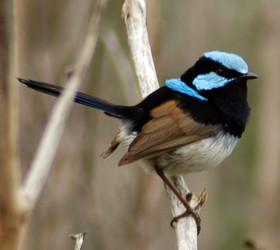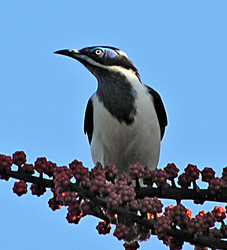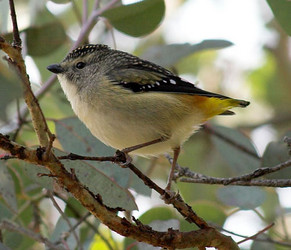Meliphagoidea



This tree diagram shows the relationships between several groups of organisms.
The root of the current tree connects the organisms featured in this tree to their containing group and the rest of the Tree of Life. The basal branching point in the tree represents the ancestor of the other groups in the tree. This ancestor diversified over time into several descendent subgroups, which are represented as internal nodes and terminal taxa to the right.

You can click on the root to travel down the Tree of Life all the way to the root of all Life, and you can click on the names of descendent subgroups to travel up the Tree of Life all the way to individual species.
For more information on ToL tree formatting, please see Interpreting the Tree or Classification. To learn more about phylogenetic trees, please visit our Phylogenetic Biology pages.
close boxDiscussion of Phylogenetic Relationships
Meliphagoidea consists of Maluridae (fairy wrens), Meliphagidae (Honeyeaters), Pardalotidae (pardalotes), Acanthizidae (scrub-birds, thornbills), and Dasyornis (bristleheads) (Cracraft and Feinstein 2000; Barker et al. 2002, 2004) and is sister to the remaining oscines (Barker et al. 2002, 2004; Beresford et al. 2005).
References
Barker, F. K., G. F. Barrowclough, and J. G. Groth. 2002. A phylogenetic hypothesis for passerine birds; Taxonomic and biogeographic implications of an analysis of nuclear DNA sequence data. Proc. R. Soc. Lond. B 269:295-308.
Barker, F. K., A. Cibois, P. Schikler, J. Feinstein, and J. Cracraft. 2004. Phylogeny and diversification of the largest avian radiation. Proc. Natl. Acad. Sci. USA 101:11040-11045.
Beresford, P., F. K. Barker, P. G. Ryan, and T. M. Crowe. 2005. African endemics span the tree of songbirds (Passeri): Molecular systematics of several evolutionary "enigmas". Proc. R. Soc. Lond. B 272:849-858.
Cracraft, J., and J. Feinstein. 2000. What is not a bird of paradise? Molecular and morphological evidence places Macgregoria in the Meliphagidae and the Cnemophilinae near the base of the corvoid tree. Proc. R. Soc. Lond. B 267:233-241.
Harshman, J. 2007. Classification and phylogeny of birds. Pages 1-35 in Reproductive biology and phylogeny of birds (B. G. M. Jamieson, ed.). Science Publishers, Inc., Enfield, NH.
Sibley, C. G., and J. A. Ahlquist. 1990. Phylogeny and classification of birds, Yale U. Press, New Haven.
Title Illustrations

| Location | Governor Phillip Park, Windsor, New South Wales, Australia |
|---|---|
| Specimen Condition | Live Specimen |
| Sex | Male |
| Source | Superb Fairy-wren (Male) |
| Source Collection | Flickr |
| Image Use |
 This media file is licensed under the Creative Commons Attribution-NonCommercial License - Version 2.0. This media file is licensed under the Creative Commons Attribution-NonCommercial License - Version 2.0.
|
| Copyright | © 2005 Brett Donald |
| Scientific Name | Entomyzon cyanotis |
|---|---|
| Location | Brisbane, Queensland, Australia |
| Specimen Condition | Live Specimen |
| Source | 731 Blue-faced Honeyeater (Entomyzon cyanotis) |
| Source Collection | Flickr |
| Image Use |
 This media file is licensed under the Creative Commons Attribution-NonCommercial-NoDerivs License - Version 2.0. This media file is licensed under the Creative Commons Attribution-NonCommercial-NoDerivs License - Version 2.0.
|
| Copyright | © 2007 Jenny |
| Scientific Name | Pardalotus punctatus |
|---|---|
| Location | Canberra, Australian Capital Territory, Australia |
| Comments | Female Spotted Pardalote sitting in a street tree in Canberra. |
| Specimen Condition | Live Specimen |
| Sex | Female |
| Source | Spotted Pardalote |
| Source Collection | Flickr |
| Image Use |
 This media file is licensed under the Creative Commons Attribution-NonCommercial License - Version 2.0. This media file is licensed under the Creative Commons Attribution-NonCommercial License - Version 2.0.
|
| Copyright | © 2006 Julian Robinson |
About This Page
Page copyright © 2006
All Rights Reserved.
- First online 31 July 2006
- Content changed 31 July 2006
Citing this page:
Tree of Life Web Project. 2006. Meliphagoidea. Version 31 July 2006 (under construction). http://tolweb.org/Meliphagoidea/67961/2006.07.31 in The Tree of Life Web Project, http://tolweb.org/











 Go to quick links
Go to quick search
Go to navigation for this section of the ToL site
Go to detailed links for the ToL site
Go to quick links
Go to quick search
Go to navigation for this section of the ToL site
Go to detailed links for the ToL site